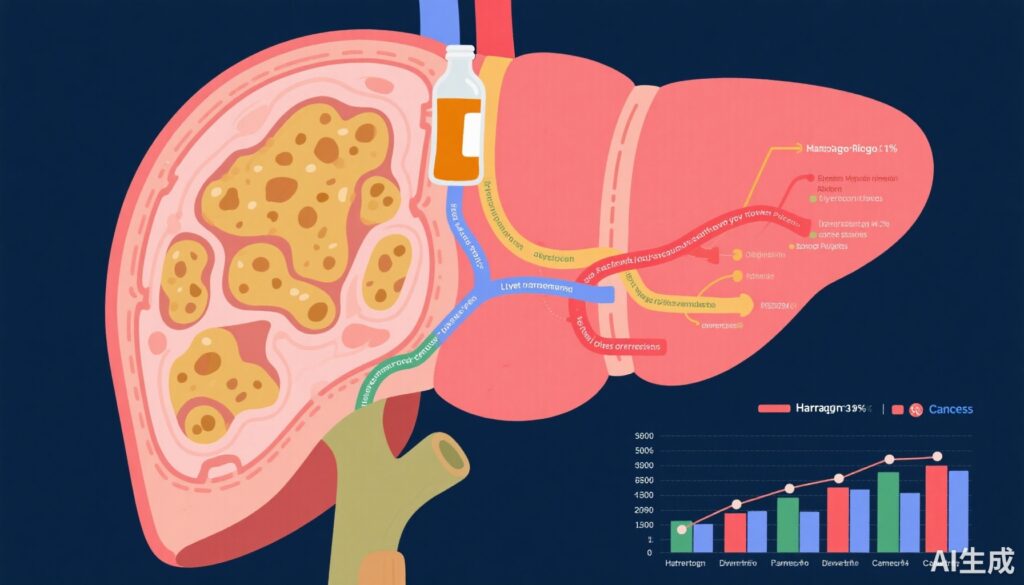Highlight
- Metabolic dysfunction and alcohol-associated steatotic liver disease (MetALD) carries significantly higher risks of liver-related complications compared to metabolic dysfunction-associated steatotic liver disease (MASLD).
- MetALD is associated with increased incidences of hepatocellular carcinoma and extrahepatic cancers versus MASLD.
- Cardiovascular event risk and all-cause mortality rates do not significantly differ between MASLD and MetALD groups.
- The findings underscore the need for distinct clinical management strategies and targeted pharmacological trials for these overlapping but distinct liver diseases.
Study Background
Steatotic liver diseases encompass a spectrum of conditions characterized by liver fat accumulation and associated metabolic and inflammatory dysfunction. Among these, metabolic dysfunction-associated steatotic liver disease (MASLD) and metabolic dysfunction and alcohol-associated steatotic liver disease (MetALD) have been recognized as distinct entities with overlapping yet differing etiologies. MASLD primarily arises from metabolic derangements such as obesity, insulin resistance, and dyslipidemia, whereas MetALD denotes coexisting metabolic dysfunction and significant alcohol use, further complicating the liver injury profile.
Given the clinical and mechanistic overlap between these entities, their long-term hepatic and extrahepatic outcomes remain insufficiently characterized comparatively. Clarifying differential risks is critical to optimize screening, risk stratification, and therapeutic intervention in these prevalent liver diseases that contribute substantially to global morbidity and mortality.
Study Design
The study is an extensive systematic review and meta-analysis registered with PROSPERO (CRD420251003928) that evaluated longitudinal cohort studies up to March 1, 2025. Inclusion criteria mandated comparative studies of adult patients diagnosed with MASLD versus MetALD that incorporated rigorous statistical adjustment for confounders.
Data sources comprised PubMed, Scopus, and Cochrane Central Register of Controlled Trials, focusing on observational cohorts rather than case-control or cross-sectional designs to ensure temporal outcome assessment. The primary outcome was liver-related events, encompassing hepatic decompensation and other hepatic complications. Secondary outcomes included hepatocellular carcinoma (HCC), liver-related mortality, cardiovascular events, extrahepatic cancers, and all-cause mortality.
Hazard ratios (HRs) and 95% confidence intervals (CIs) were pooled with random-effects models accounting for heterogeneity. Publication bias was assessed with Egger’s regression tests.
Key Findings
The meta-analysis synthesized 24 cohort studies including over 11.5 million individuals: approximately 9.8 million with MASLD and 1.77 million with MetALD. Demographically, MASLD patients were older on average (mean age 57.0 years) with near-even sex distribution (~62% male), whereas MetALD patients were younger (mean age 48.6 years) and predominantly male (~82%).
Liver-Related Events
Individuals with MetALD exhibited a significantly higher risk of liver-related events compared to those with MASLD (HR 1.62, 95% CI 1.16–2.25, p=0.0086). This suggests that the additive effect of alcohol and metabolic dysfunction exacerbates liver injury progression.
Hepatocellular Carcinoma
MetALD was associated with a higher incidence of hepatocellular carcinoma relative to MASLD (HR 1.33, 95% CI 1.00–1.77, p=0.048), indicating enhanced hepatocarcinogenic potential when alcohol use compounds metabolic liver disease.
Extrahepatic Cancers
Though modest, the risk of extrahepatic cancers was elevated in MetALD (HR 1.03, 95% CI 1.01–1.06, p<0.0001), highlighting broader systemic carcinogenic consequences of combined metabolic and alcohol-related insults.
Cardiovascular Events and Mortality Outcomes
Cardiovascular event rates were statistically similar between the MASLD and MetALD groups (HR 0.96, 95% CI 0.85–1.09, p=0.48), reflecting the dominant effect of metabolic dysfunction on cardiovascular risk regardless of alcohol use.
All-cause mortality and extrahepatic cancer-related mortality did not significantly differ, with HRs of 1.08 (95% CI 0.97–1.19, p=0.14) and 1.44 (95% CI 0.97–2.15, p=0.065) respectively. However, these outcomes showed greater heterogeneity and possible publication bias for cancer-related mortality.
Heterogeneity and Bias
Considerable heterogeneity was noted across most analyses (I2 between 76% to 93%), possibly reflecting variability in population demographics, diagnostic criteria, alcohol consumption thresholds, and follow-up durations. Only extrahepatic cancer incidence had low heterogeneity (I2=0%).
Egger’s test largely excluded publication bias except for extrahepatic cancer-related mortality, suggesting robustness but indicating some caution in interpreting mortality outcomes.
Expert Commentary
This meta-analysis robustly delineates the differential risk profiles of MASLD and MetALD. The elevated risk of liver-related events and HCC in MetALD underscores the synergistic hepatotoxicity of alcohol in the background of metabolic liver injury. The findings align with mechanistic insights whereby combined insults potentiate liver inflammation, fibrosis, and oncogenesis.
Interestingly, cardiovascular risks were not significantly different, consistent with cardiovascular disease being predominantly driven by metabolic derangements rather than alcohol alone in these populations.
Limitations include study heterogeneity, reliance on observational data, and potential residual confounding despite adjustments. Moreover, variable definitions of alcohol exposure and liver disease limit uniform interpretation.
Clinicians should recognize MetALD as a higher risk phenotype within steatotic liver disease and consider tailored monitoring and therapeutic approaches. These data also advocate for dedicated clinical trials to evaluate targeted pharmacotherapies in MetALD distinct from MASLD.
Conclusion
MetALD patients face significantly greater risks of liver-related complications, hepatocellular carcinoma, and extrahepatic cancers compared to MASLD patients. However, cardiovascular events and mortality outcomes are comparable. This comprehensive meta-analysis highlights the clinical importance of differentiating these overlapping liver disease subtypes for prognostication and personalized care strategies. Future research should focus on refining risk stratification and developing specific therapeutic interventions tailored to the nuances of MetALD and MASLD.
Funding and Registration
This study was funded by the Italian Ministry of Education, University, and Research (MIUR) and registered prospectively on PROSPERO (ID: CRD420251003928).
References
Celsa C, Pennisi G, Tulone A, Ciancimino G, Vaccaro M, Pecorella F, Di Maria G, Enea M, Midiri F, Mantovani A, Targher G, Krag A, Rinella ME, Cammà C, Petta S. Risk of hepatic and extrahepatic outcomes associated with metabolic dysfunction-associated steatotic liver disease and metabolic dysfunction and alcohol-associated steatotic liver disease: a systematic review and meta-analysis. Lancet Gastroenterol Hepatol. 2025 Nov;10(11):998-1012. doi: 10.1016/S2468-1253(25)00188-8. Epub 2025 Sep 12. PMID: 40953570.


